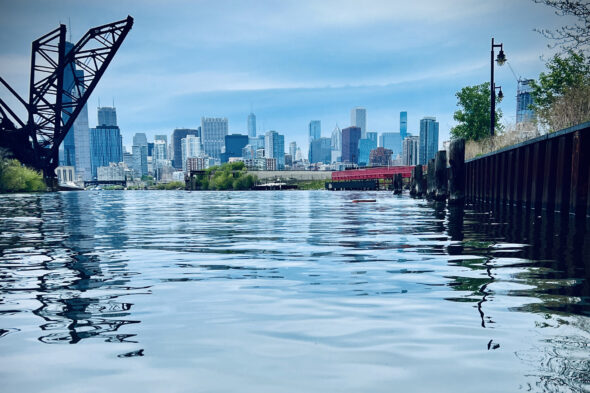Plan calls for recycling wastewater to avoid Chicago region water crisis
As municipalities contract with the City of Chicago to supply fresh water from Lake Michigan, a new report from University of Illinois Chicago researchers recommends that plans include supplying recycled water for industry to avoid looming issues related to the region’s water supply.

The report, which was produced by the Freshwater Lab at UIC in partnership with UIC’s Great Cities Institute, details a proposed “dual-pipeline” solution: A system featuring one line that supplies industrial sites with treated wastewater and another for conveying drinking water to homes, healthcare facilities and other places requiring potable water.
The researchers recommend that every new community that applies to build a pipeline to draw water from Lake Michigan build a second one for recycled wastewater. They said this will help meet the area’s drinking water needs, divert wastewater out of area rivers and support industrial economic growth in northern Illinois.
“Many more communities are going to need water from Chicago, but Illinois has a cap,” on what it can pull from Lake Michigan, explained Rachel Havrelock, founder of the Freshwater Lab, a humanities-based initiative focused on research, teaching and public awareness about the Great Lakes. “This needs to be thought about now.”
With a $100,000 grant from the Metropolitan Water Reclamation District of Greater Chicago, the team initially examined the feasibility of reusing water within Chicago, but shifted its focus to Joliet, Illinois, given its pressing water needs and heavy industrial footprint.
Joliet recently contracted with Chicago for Lake Michigan water access by 2030 to avoid an eventual water shortage due to the collapsing Cambrian-Ordovician aquifer, the groundwater source serving communities in Will, Kane and DuPage counties. Joliet alone has drawn down its portion of the aquifer by 800 feet.
In the future additional communities linked to the collapsing aquifer will request agreements with Chicago for water, but eventually, the city will have to decline due to legal limits set by the U.S. Supreme Court.
The UIC team hopes that federal and state funding can be secured to integrate the dual-pipeline system into the Joliet project, which is just beginning construction.
“When better than now to start?” said Teresa Córdova, director of the Great Cities Institute. “There’s no reason we should be using drinking water for industrial use when we have a viable alternative.”
The researchers recommend building the second pipeline within the same easement as the initial Joliet pipeline, which would avoid the need to acquire additional land along its 30-mile path. The estimated cost for building the second pipeline is $285 million, approximately the same cost for the first pipeline.
The second pipeline would be connected to one of two wastewater reclamation plants, where wastewater is currently collected and treated to levels that make it safe to release into the rivers.
An additional $78 million or $114 million would be needed for the connecting line, depending on which plant it ran to, according to the researchers’ estimates.
In both scenarios, the second pipeline would carry enough water to supply Joliet and the surrounding communities with its industrial water needs.
The idea to recycle water was already of interest to each of the researchers when they teamed up on the proposal, which is modeled after a water recycling project in El Segundo, California. Built in 1995, that system provides approximately 40 million gallons of recycled water daily to industrial users to free up drinking water in drought-stricken Southern California.
The proposal is presented with an understanding of Chicago’s long history of sending wastewater south, as well as how wastewater is currently managed in the region. MWRD runs the Deep Tunnel system, a 109-mile project that provides an outlet for rainwater before being treated and diverted to the Chicago Sanitary and Ship Canal for eventual travel to the Gulf of Mexico via the Mississippi River.
This resource-intensive but wasteful process was one of the things that piqued UIC engineering professor Krishna Reddy’s interest in the dual-pipeline concept.
“Fresh water is a precious resource and we’re taking fresh water and putting it into the ocean, making it useless,” said Reddy, UIC professor of civil, materials and environmental engineering, who is also director of the Geotechnical and Geoenvironmental Engineering Laboratory and the Sustainable Engineering Research Laboratory.
Funds allocated for Illinois water infrastructure in the federal infrastructure act, as well as money from the Environmental Protection Agency, are among potential funding sources suggested by the UIC team. They also recommend that MWRD wholesale the recycled water to the Chicago Department of Water Management. Overall, the proposed dual-pipeline project will eventually pay for itself by “turning waste into revenue,” Havrelock said.
